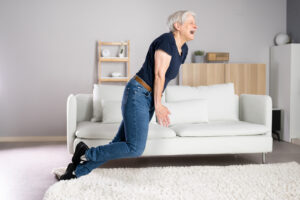Common Areas That Seniors Fall

Elder Care in Silver Lake
As a person ages, the body changes, and some conditions that your parent may be dealing with might cause him to lose balance or suffer from vertigo. Both of these conditions can increase his risk of falling. Falling puts him at greater risk for injury, whether it’s just a bad bruise or a long-term consequence, such as a broken hip or a concussion.
To help your elderly parent avoid falls, you first need to know where falls are most likely to occur. While most of us know that we have to be careful on the ice or uneven ground, most falls occur in the home and in areas where your parent travels every day.
In the Home
While stairs are always a big concern, just because your parent’s place of residence doesn’t have stairs, it doesn’t mean he won’t trip and fall. Here are the most common areas in a home where falls occur when stairs aren’t involved:
- Living rooms (31 percent of falls)
- Bedrooms (30 percent)
- Kitchens (19 percent)
- Bathrooms (13 percent)
- Hallways (10 percent)
As you review these areas in your parent’s home, look for obvious tripping hazards, such as loose rugs, items piled on the floor (like shoes by a door), and cords that run across floors. Some of these things we see so often and are so used to navigating around, that we stop actually seeing them. A good idea is if you have elder care providers coming to your residence to help your parent. Ask them to assess what they see as possible tripping hazards. A fresh pair of eyes can help you see things in a new light.
If stairs are part of your elderly parent’s living quarters, then you’ll want to make sure each set of steps has a sturdy handrail (or two), good lighting, and solid steps without any uneven flooring. Your parent will need to turn on the lights for the stairs, both from the top and the bottom. Illuminate the path by placing small night lights on each step.
In the Community
After in-home falls, the most common type of falls occurs outside the home and in the community. About thirty percent of falls happen in places like sidewalks, shopping areas, and other indoor areas. Have someone join your parent for trips out, like an elder care provider. This can help her avoid some falls by having an arm to hold onto and another pair of eyes to see if there is something on the ground that should be avoided.
In Healthcare Centers
Finally, about 10 percent of falls happen in healthcare centers, such as hospitals and rehabilitation centers. If your parent has a trip to the doctor or clinic, then have an escort. For instance, an elder care provider can help her navigate unknown areas. This will prevent tripping or stumbling over an unexpected step or change in flooring.
If you or an aging loved one are considering hiring Elder Care in Silver Lake, CA, please contact the caring staff at Home Care Help. Serving All of Los Angeles County. Call Us Today at (888) 989-7388.
Source:
https://www.lively.com/health-and-aging/elderly-falls-statistics/
- 5 Ways To Help Your Senior Parent Get More Fiber In Their Diet - December 5, 2024
- The Emotional Impact of Parkinson’s for Seniors Aging in Place - November 20, 2024
- Understanding Calorie Intake and Physical Activity for Senior Health - November 6, 2024
